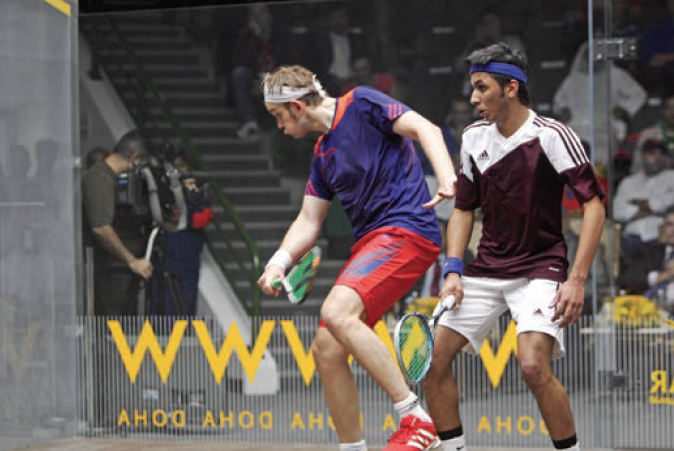
By Richard Millman
Picking up where we left off last month, you’ll recall that “a deep understanding of how to create a ninety-degree angle between the racquet and the direction that you wish the ball to go in “is a fundamental technique every squash player must master—and ‘head turn progressions’ is an advanced skill that you can use to maintain that ninety-degree angle of contact when under pressure.” Here’s the formula we promised:
1. Easy—When the ball is loose and in open court.
Set up in the normal way and allow your eyes and head to rotate through, following the ball’s path as you recover. Your eyes, head, chest and hips all rotate all the way through the stroke much like a golfer hitting a full golf shot— except we are low and mobile and they are upright and static.
2. Moderately Difficult—The ball is on the side wall.
In this scenario you have very little margin for error as the side wall is giving a physical obstacle to any inaccuracy in your 90 degree production. To ensure maintenance of the angle, keep your head and eyes focused on the point of strike (where the ball is/was when you hit it) even after the ball has gone. At this point you need to follow the ball mentally with your imagination, while keeping your eyes toward the contact point. Your eyes then catch up with your mind and the ball milliseconds after completion of the shot. Make sure you have arrived ready to leave marginally before you swing so that your legs are being used to provide momentum for both the recovery movement and the ball strike.
3. Quite difficult.
Despite your best intentions the ball has gotten slightly beyond you and it is now beyond the ideal 90 degree angle to the direction that you wish to hit it.
As you strike the ball, increase the head turn in the opposite direction to that which you are hitting the ball and also proportionally increase the amount of wrist you are using—in order to be able to reach behind the ball and maintain the 90 degree angle with the racquet head.
Again, as your head and eyes look be- hind the point of strike, your mind tracks the ball’s progress forward and you re-gather mental/visual contact with the ball moments after execution.
4. Very difficult.
The ball is right in the back corner either dying or hardly coming off of the back wall.
Increase the degree of reverse head turn (away from the direction you are hit- ting), and of the use of the wrist. The more difficult the ball is (which, if you have your racquet up before you start the approach, you will automatically perceive) the more you need to turn your entire body before you get to the situation, not forgetting that your first priority when you get there is to start leaving and then execute the shot, so that your leg strength supplies momentum to the racquet swing and hence to the ball.
5. The most difficult.
The ball has not only gotten beyond you but has struck the side wall, bounced on the floor and is barely coming off of the back wall while traveling almost parallel to the back wall.
This calls for the most extreme head turn progression; an entire reverse turn away from the direction of strike—a pirouette in the opposite direction to that which you are hitting the ball, executed while hitting the ball with a great deal of wrist and a choked-up, severely open grip.
Before you move to the shot, you have already turned the back of your legs to- ward the ball, and marginally before you strike you look completely away from the ball, hit the ball behind your calf muscles and pick the ball up visually before it strikes the front wall—staying crouched low throughout.
Obviously this is a very advanced technique, but the logic is a simple continuation of the earlier variants—just much more extreme.
So to conclude, head turn progressions follow a simple principle. The more difficult a situation is the more you turn your head and body away from the front wall, choking up and opening the grip in extreme circumstances.
I don’t expect you to be able to execute the most difficult method on your own immediately. But it is important that you are aware that these skills are available to you. Working with a coach and with plenty of patience, there is almost no ball that you are incapable of returning with Nick Matthews’s surgical precision and by using these head turn progressions.





